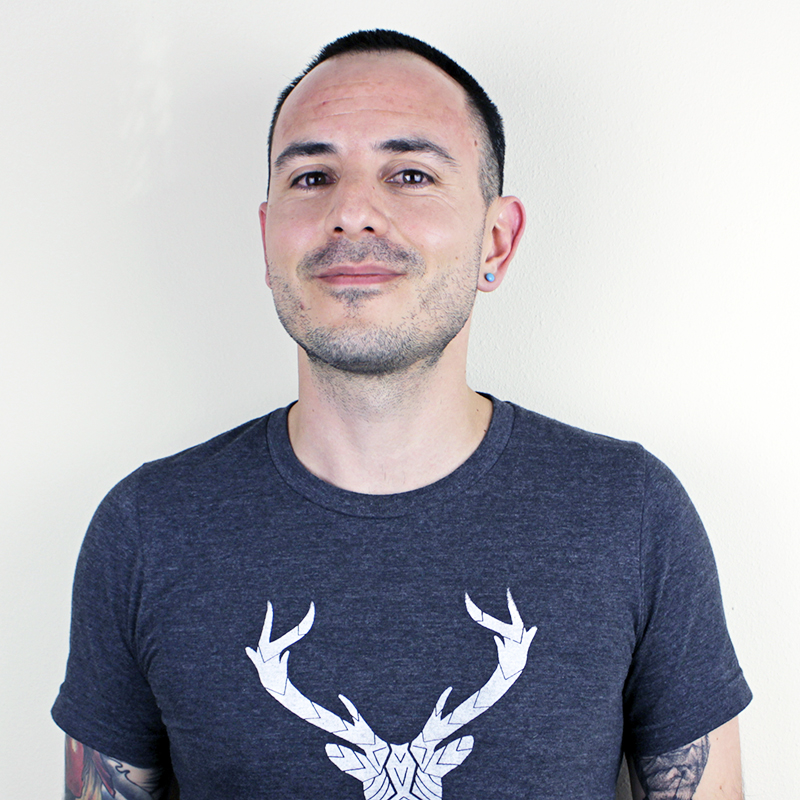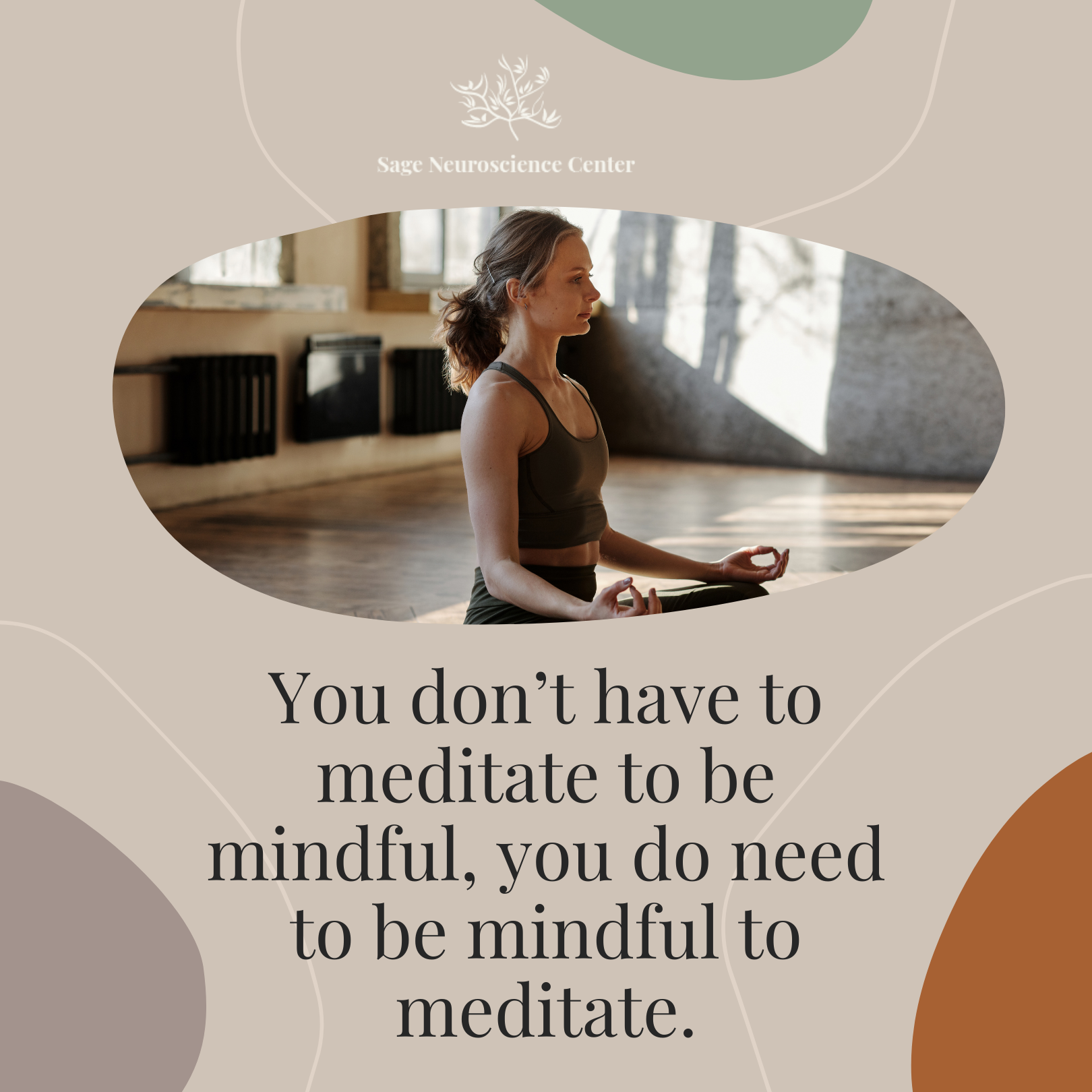It can be all too easy for many of us to conflate the ideas of mindfulness and meditation—this can become especially confusing for people because the terms, themselves, are often used interchangeably. So, as we’re sure you’re asking: Is there even a difference between mindfulness and meditation? The simple answer is that, yes, there is a distinction worth noticing.
That’s what we’d like to discuss today, to hopefully build a clearer understanding of these beneficial (but not entirely the same) concepts.
Mindfulness vs. Meditation
What’s the difference between mindfulness and meditation?
Sage Therapist Andres Duran, LPCC answers this popular question in the following video. Watch and then keep reading for more tips on how you can practice mindfulness and meditation in your own life.
Meditation Is Spiritual in Nature
To begin, the clearest distinction pertains to the source philosophies of each idea. Generally, mindfulness is considered to be a secular practice. On the other hand, meditation is most accurately described as a spiritual practice, which might incorporate some form of ritual or ceremony. Across world religions, we often find different forms of meditation as a piece of spiritual practice, whether that be in the form of prayer or another form of contemplative meditation.
Mindfulness Is Non-Spiritual
Mindfulness, however, is the non-spiritual byproduct of meditation. It’s what humanity has learned from these practices, even without the attachment of a specific spiritual or religious belief. Mindfulness is the practice studied by scientists and psychologists; it’s also the crux of meditative traditions, no matter the religious basis or other rituals involved. Mindfulness is practiced across cultures in a variety of forms.
Following the research of mindfulness by scientists and psychologists, we’ve derived particular skills, which are then usable by (and likely beneficial to) all people who choose to practice them—no matter that person’s background. In that way, mindfulness can be considered a practical experience, whereas meditation is typically formal, with more rigid means of practice. For example, certain spiritual beliefs may consider chanting necessary for proper meditation; they might also require a specific bodily position, such as sitting. With meditation, rituals are common, and they vary from tradition to tradition. Mindfulness is far more fluid from person to person and can be practiced however best suits the practitioner.
Mindfulness Useful Therapy Tool
Mindfulness skills can be found throughout a variety of therapeutic forms. In particular, DBT (or dialectical behavior therapy), whether through individual or group sessions, emphasizes a large variety of these skills. Through DBT, mindfulness skills are detached from spirituality or formal ritual and are presented in a way that is accessible to a variety of people. These “what” and “how” skills are easy to use, even if a person is in the car or at the grocery store. Any time, any place. That accessibility is by design.
Simply put, while you don’t have to meditate to be mindful, you do need to be mindful to meditate. This is the crux of what mindfulness even is: a tool for any of us to use, whether or not it’s a component of a spiritual practice or a ritual.
Mindfulness and How It Empowers You
Surely, we’ve all heard about just how beneficial mindfulness can be to a person—whether to alleviate anxiety or simply reorient and better focus our minds. But why is this? Why is the practice of mindfulness so beneficial to a person’s psychological (and sometimes even physical) well-being?
Well, the practice is far more than just striving to become centered and calm. If anything, that’s what you might expect from repeated practice of mindfulness, rather than being the direct result of any one mindfulness exercise.
It Improves Feelings of Well-being
In the same vein as diet or exercise, long-term practice of mindfulness and its related techniques can gradually work to improve a person’s overall well-being. With a consistent mindfulness routine, one might begin to achieve that sense of peace and calm, often associated with the practice. Still, that isn’t to say that this is the best possible result of mindfulness practice. Instead, more than any inner calm or tranquility, practitioners of mindfulness can expect to gain better control of their minds.
Mindfulness Improves Focus
With improved control of one’s mind, a person can better control what their attention is focused on—ultimately, this is the predominant effect of long-term mindfulness practice.
As a bonus, it’s also been shown that we’re encouraging the release of feel-good chemicals within the brain by making a habit of mindfulness. Further, a mindfulness practice might lower blood pressure, improve digestion, and help relax physical tension or pain.
Not only does mindfulness encourage all these benefits, but more importantly, it’s an accessible practice that anyone can introduce into their own lives.
How to Begin Practicing Mindfulness

Start With Your Five Senses
Be aware of what’s being noticed through sight, touch, hearing, smell, and taste. Using the example of washing the dishes, notice how the water feels on your skin, notice the scent of the dish soap, the sound of the running water, and what you see in that particular moment. Home in on as many senses as you can, and allow yourself to be present in any activity. Break down your experience of the task. This is a straightforward way to practice mindfulness in your everyday life, using tasks you’re already doing.
Direct Your Attention
During mindfulness practice, you should attempt to direct your attention to the here and now, focusing on your present environment and activity. The goal is to free yourself from both your past and present, even if you can only manage this for a short period. Work to observe without judgment, whether that judgment falls onto yourself or onto an aspect of your environment.
Unfortunately, it’s easy to fall into the trap of believing you’re doing mindfulness “wrong.” After all, why can’t you seem to pull your attention back to your immediate environment? Why are you so trapped in your head, no matter how hard you try to refocus your attention?
Our Minds Are Hardwired for Distraction
That’s to say when your mind begins to wander during a mindfulness exercise, it’s only doing what it was built to do. Even the most devoted practitioners of mindfulness experience some level of distraction during their practice. Don’t beat yourself up and expect perfection. In the case of mindfulness, the only “perfection” is whatever works for you and your own mental well-being. No pressure required.
Mindfulness and the Pandemic
During the pandemic or any other major catastrophe, people often begin to feel a dwindling sense of control. For many, this lack of control can grow distressing and become challenging to manage. That’s exactly why establishing a practice of mindfulness can be so beneficial, especially in times of unrest or uncertainty.
Through practicing mindfulness, we’re able to pull our attention away from what we can’t control and onto what we can. Even if we lack direct influence over the events that we experience, mindfulness can show where our limits are, but it can also draw attention to making a change.
Mindfulness and Rumination
It can be easy to get trapped in our own heads during stressful or high-tension times. People are then prone to ruminating, where we proceed to rehash the same distressing thoughts again and again—whether the problem is within our control to fix or not. Maybe you miss seeing your friends and begin to ruminate on that. Or perhaps you can’t stop thinking about how much you’d like to travel. Rather than continue to dwell, mindfulness allows us to begin redirecting our attention away from our distress and onto something else—something that’s happening in the present that we can either change or enjoy.
Practice Mindfulness Any Time, Anywhere


Licensed Clinical Mental Health Counselor, DBT Therapist, and BHIOP Facilitator
Andres Duran, LPCC, is a clinical mental health counselor and clinical supervisor with Sage Neuroscience Center. He focuses his clinical work on the intersection of behaviorism and mindfulness striving to bring compassion and change to the individuals and couples he works with. He is endlessly curious, an avid reader, and a world traveler
Read Andres Duran’s Full Bio | Browse All Articles Written by Andres Duran, LPCC

